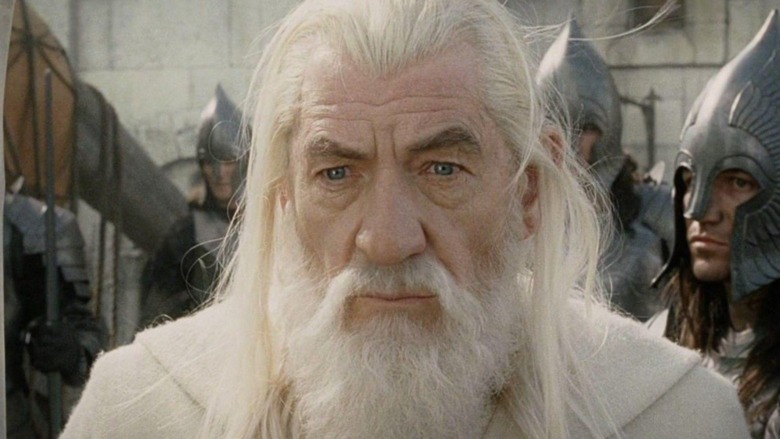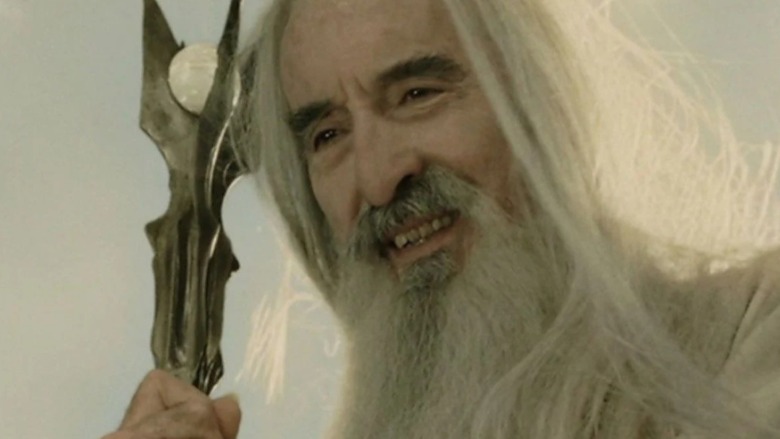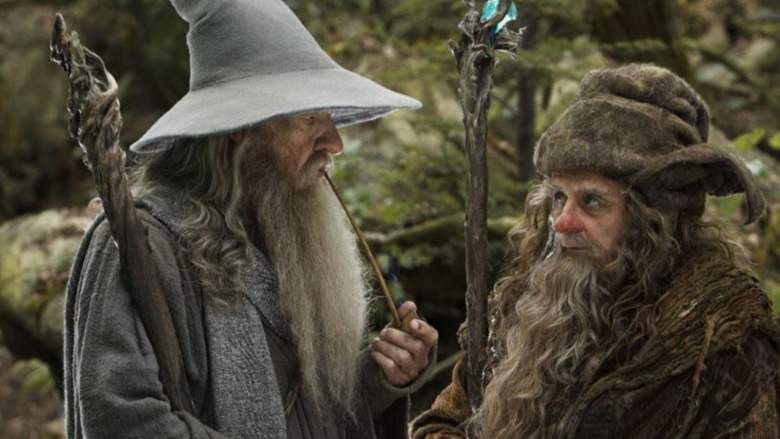What Only Hardcore Tolkien Fans Know About Middle-Earth's Wizards
There's no denying that the late J.R.R. Tolkien was one of the most influential fantasy authors of all time. His works such as The Hobbit and the famed Lord of the Rings trilogy set the standard for all others in their class, and the wider Middle-earth legendarium is a prime example of how to pull off fictional worldbuilding. Tolkien's canon boasts a wide array of cultures, locales, and a complex creation story that makes it feel like a historical timeline. That is, until one takes a deeper look at its more fantastical elements, like the Istari, better known as the wizards.
All across Tolkien's writings, the Heren Istarion — which translates to Order of the Wizards — make their presence felt, for better or worse. Perhaps the best known of the bunch are Olórin and Curumo, recognized most commonly by their respective monikers, Gandalf the Grey and Saruman the White. They were joined by three others: Aiwendil, or Radagast the Brown, and Rómestámo and Morinehtar, or the Blue Wizards, Alatar and Pallando, who play a more passive role in the chronology. Nevertheless, they all arrived in Middle-earth for a reason, and played their part in ways expected and unexpected.
For those unfamiliar with these angelic beings, here are some important details about them that only hardcore J.R.R. Tolkien fans know about.
A duty to combat evil
Ages before the War of the Ring, and even prior to Thorin and Company making their voyage to reclaim the Lonely Mountain, the dark lord Morgoth was no more and peace seemed possible in Middle-earth. However, in his stead, Sauron began his ascent to power and threatened to destroy all who opposed him. In response to his growing strength, the Valar (the immortal beings that shaped Middle-earth) elected to call on the Maiar spirits for aid. Only Curumo and Morinehtar answered their plea initially, but they were joined by Olórin, Aiwendil, and Rómestámo soon after.
With their forces assembled, the five Maiar were reincarnated as the Istari, or wizards of Middle-earth, and arrived in the Grey Havens in the year 1000 of the Third Age. Tasked with guiding the Free Peoples in their fight against the ultimate evil, each took their own path to do so. Saruman led the party, settling in Isengard and enveloping himself in his studies of Sauron's power. Second in command was Gandalf, who wandered throughout Middle-earth and mingled with its people. Radagast became enamored with wildlife and all but abandoned his quest, and Pallando and Alatar traveled East to stir up revolt against Sauron.
Bound to a mortal form
Bearing in mind their divine origins, and their vast wealth of magical abilities, one has to wonder, why do all five of the wizards take the form of elderly men? Well, to put it simply, this was a condition of their introduction to Middle-earth set forth by the Valar. They didn't want them to dominate those they were tasked with working alongside to stop Sauron, so transforming them into old human men was their grand solution. Not to mention, being stuck in their wizard forms affected their abilities and decisions.
For one, their new bodies were no different than those of the average person aside from enhanced strength and intellect. Though their flesh and spirits were immortal, their physical form could be harmed and even killed. Not to mention, their full Maiar power set was drastically reduced to ensure they didn't abuse it once they arrived in Middle-earth. They also lost some of their previous knowledge of Valinor (the realm where the Valar reside) before becoming wizards, and they'd lose more if they broke any of the rules set before them.
By the time Sauron was finally defeated, Saruman's greed got the best of him, costing him his life and status as the leader of the Order of Wizards. Gandalf took his place after being reborn as Gandalf the White, and the fate of Radagast, Alatar, and Pallando is unknown. No matter their path, the wizards certainly left their mark on Middle-earth in ways big and small, and in doing so, became some of the most important — and least important — individuals in Tolkien's literary works.


